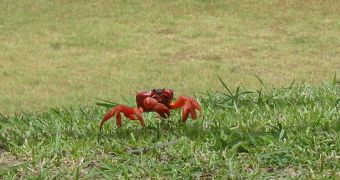In a new scientific investigation, researchers determined that temporary hormonal changes are what allow millions of Christmas Island red crabs to carry on their annual mating migration.
Widely acknowledged as one of the wonders of the modern world, the migration of red crabs takes place every year over a swath of land measuring 5 kilometers.
Millions of the creatures embark on this glorious march, which makes the entire event appear as if a moving, red carpet has blanketed the ground.
However, researchers have been puzzled at how the crabs managed this athletic feat for a long time. They explain that their bodies simply don't have what it takes to complete the journey.
Considering that the animal is only a few inches long, how it manages to travel non-stop for 5 kilometers becomes a very valid question.
A collaboration of scientists led by the late professor Steve Morris, in collaboration with professor Simon Webster, revealed that the bodies of the red crabs undergo hormonal modifications before the migration.
The new, special power they obtain are used so that they can travel to the ocean, and lay their eggs in the water. Usually, the crabs live in burrows on land, where they hide during the day to avoid drying out.
Morris was the leader of the three-year investigation that led to this conclusion. He held an appointment in the School of Biological Sciences at the University of Bristol, in the United Kingdom.
Expert Simon Webster is a professor at the Bangor University. Full details of the work appear in the September issue of the esteemed Journal of Experimental Biology.
“During the wet season on the island, in November or December, and prompted by the arrival of the monsoon rains, millions of the crabs undertake an arduous breeding migration from their home on the high rainforest plateau to the ocean to reproduce,” says UB expert Lucy Turner.
“This is a journey of several kilometers – a long way when you are a relatively small land crab,” she adds.
“Scientists have long been puzzled by what mechanisms enable the necessary changes to take place in the crabs’ physiology to allow this journey to take place, and how they make such a dramatic switch from hypoactivity to hyperactivity,” Turner explains further.
It would now appear that during the migration the crabs make good use of the Crustacean Hyperglycaemic Hormone (CHH), which allows them to utilize the energy they have stored in the most efficient way possible.

 14 DAY TRIAL //
14 DAY TRIAL //